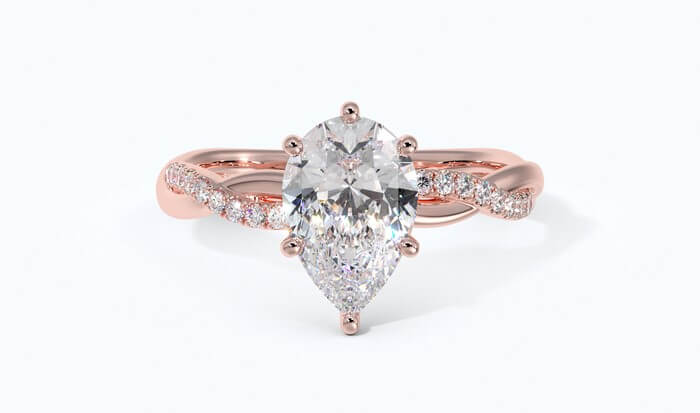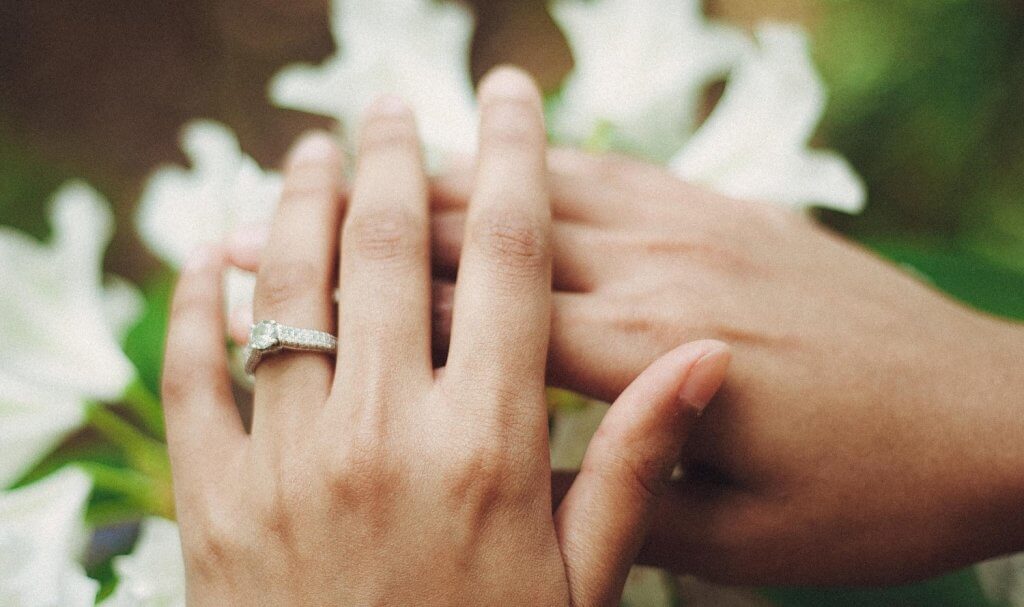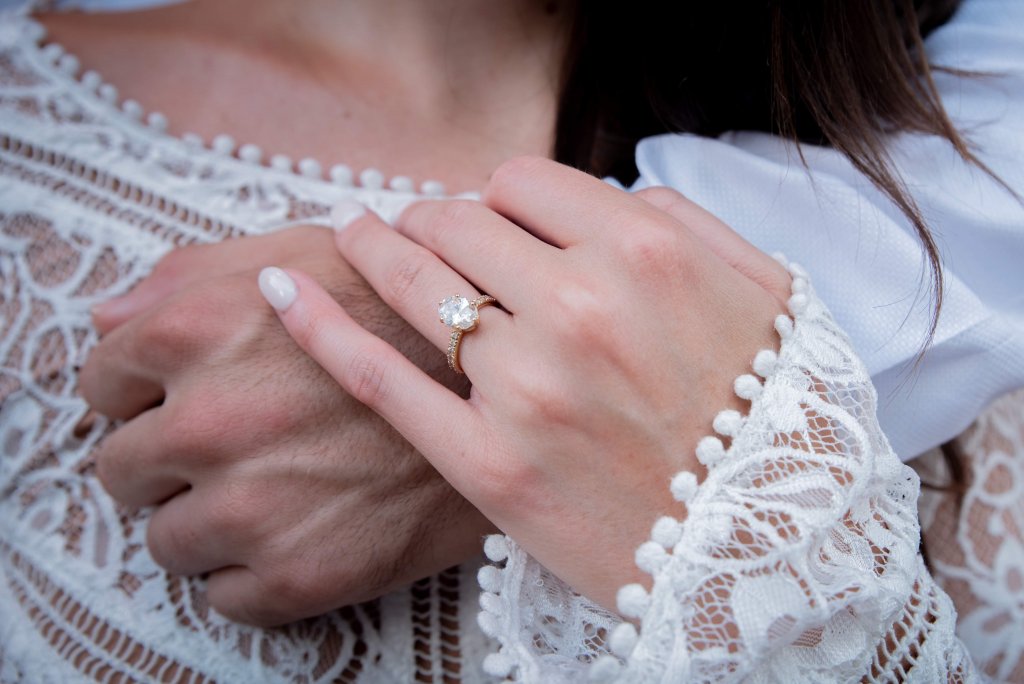Pear Shaped Diamond Ring Settings: The Complete Guide
Key Takeaways
- The Pear cut, also known as Teardrop, is a perfect amalgamation of the Round Brilliant and the Marquise.
- It is a beautiful shape, with a unique light performance and a silhouette which can lend itself to many different setting styles.
- There are different Pear cut diamond settings, including the Pear solitaire, the split shank Pear engagement ring and the Pear cut pave engagement ring.
- As well as these, there are also modern cuts to consider. These include the Pear cut bezel ring and the Pear cut tension setting.
- You need to pay attention to proportion and ratio, as it is a tricky shape to get right.
- If you choose to go for the Pear cut, it will be best to get the wedding band designed to accommodate the shape, or you may end up with an unsightly gap.
- This can easily be done, especially if you return to the jeweler who designed the ring.

A cut featuring the perfect combination of shapes, the Pear cut perfectly marries together the classic Round Brilliant and the bold, elegant Marquise. A little less of a novelty than the Heart shape, it offers an echo of that romantic symbol – and of the tears of happiness an engagement tends to bring out of us.
Beyond the symbolic appeal of the Pear cut, however, it’s simply a beautiful shape with a distinctive light performance, and a great silhouette that lends itself to many, many different setting styles.
One of the great things about the Pear is that it has been around a long, long time – since the 1400s – and remains popular to this day. For you, that means that you can go as modern or as classic as you want – or embrace both elements in your ring’s design.
Timeless Pear Cut Diamond Settings
The Pear cut has a modern feel to it, but its long history means that it’s always possible to emphasize the timeless side to these diamonds…
The Pear Solitaire
The Pear shape is striking enough to stand out on its own, without the need for any extra embellishments, and embracing the most classic design of all means that your ring will never be the subject of changing fashions or trends. More so than the Round or Emerald, the Pear cut can drift in and out of popularity, but a design as simple and timeless as the solitaire is pretty much immune.
More recently, a number of designs have popped up featuring the Pear cut set horizontally across the finger, rather than vertically. While bold and indisputably ‘new’, the design banks on you being okay with a ring that is defined by asymmetry. It’s a great way to reinvent the solitaire but, for many people – and, in particular, people who admire the shape of the Pear without worrying about passing trends – the Pear solitaire may not need reinventing.
Split Shank Pear Engagement Ring
Like the solitaire, the diamond itself can command all the attention in a split shank setting. As an elongated shape, the double shank is highly flattering, and appears to branch out towards the tip and base of the diamond in a way that is elegant, yet unobtrusive.
Pear Cut Pavé Engagement Ring
Feminine, sparkly, and highly romantic, the Pear’s brilliance and fire can be echoed perfectly within a pavé shank. If you want to go even further, consider a halo – but for the perfect combination of elegance and extravagance, a pavé band lends the ideal ‘backdrop’ do your diamond.
Modern Pear Cut Diamond Settings
Timelessness will always have its appeal but breathing new life into the usual designs is a great way of appealing to bride-to-be with a more contemporary vibe.
Pear Cut Bezel Ring
A bezel is a solid ribbon of metal that wraps around the full edge of the diamond. It’s a little less common in engagement rings, predominantly because it blocks considerably more of the diamond from the light, limiting its sparkle. Of course, bezel-set diamonds still produce fire and brilliance, but compared with prong-set diamonds, there is a noticeable difference.
The bezel is, however, beautifully modern and minimalistic. Against yellow gold, the luminescent quality of the diamond is brought into sharp relief, while the design itself creates a comfortable, practical, and streamlined ring that emphasizes the shape of the Pear.
Alternatively, a half bezel ring will echo the asymmetricity of your Pear cut and leave a little more of the stone exposed to the light. It’s a great middle ground if you love the streamlined, contemporary look of the bezel, but don’t want to disguise too much of the stone’s outer edge.
Pear Cut Tension Setting
The tension setting is one of the most fascinating to look at and relies on the pressure between the two open ends of the shank to hold the diamond in place, rather than any prongs. It’s a lot more secure than it sounds, and the results are breathtaking.
A tension setting makes it easy for you to use the Pear cut’s asymmetry to your advantage. The diamond can be set between the two ends of the shank at an angle, rather than the usual vertical arrangement. It’s a small change, but very powerful, and looks particularly attractive in white gold or silver.
Pear Shaped Accents
If you love the Pear, but prefer the versatility of a different diamond, then this cut offers the perfect accent to a center stone. Placed horizontally, they can resemble leaves or petals growing on either side of the center stone. Paired with an Emerald cut, they bring sparkle to the design – paired with a Round Brilliant, however, they create a wonderfully floral vibe (particularly on a twisted shank, or against some delicate filigree).
Things to Remember
Keep in mind that even the most striking and carefully planned ring design will be let down by a poorly cut diamond. This is, of course, true of any shape, but the Pear is a particularly tricky shape to get right. It’s all too easy for a Pear to come out looking too long and narrow, too wide and stout, or so shallow or deep that the stone’s light performance is compromised. What’s more, the precise point of the pear can be cut into the rough off-center, meaning that, when viewed from above, the diamond will be noticeably wonky.
You’ll want to make sure that the diamond has a GIA grade of Excellent or Very Good for symmetry and polish, but also that it is falls within the appropriate ranges for depth and table percentages, length-to-width ratio, girdle and culet (alongside the Four Cs, of course).
Also, the Pear Cut’s elongated shape means that it is vulnerable to the bow tie effect – a phenomenon that is, unfortunately, prevalent in Pear cuts, Marquise cuts, and Ovals.
We’ve written a full guide to the Bow Tie Effect, which makes for important reading if you’re considering one of these shapes, but the main gist is that you need to give your diamond a careful inspection (in person) before investing, in order to avoid picking one with an unsightly dark streak through the center.
Also, the Pear cut is prone to retaining color. This is a benefit for those picking out fancy color diamonds, but less convenient if you’re looking for a white diamond. If your diamond has a minor amount of color (say, it sits at I or J on the GIA scale) then a yellow or rose gold setting will be best for emphasizing the whiteness of the stone.
If you’re set on white gold or platinum, then you’ll want to invest in a higher color grade.
Which way should a Pear diamond point?
Most people prefer the look of a Pear that points toward the fingernail, not the knuckle.
Remember that there are no hard-and-fast rules about this, and your ring’s intended wearer may prefer to go against the grain when it comes to styling her ring. And, besides, if you pick something like a tension ring setting, the diamond is probably going to naturally point in a totally different direction.
Also, consider the fact that off-set diamonds are also becoming increasingly popular. Ariana Grande’s headline-making engagement ring featured an offset Oval, for instance, while Megan Fox’s engagement ring features two off-set Pear cuts – one diamond, the other emerald.
But, if your design has the Pear aligned vertically, so that it runs with the shape of the finger, it’ll be up to the wearer which way it goes on. Then again, consider this…
How do you wear a wedding band with a pear-shaped engagement ring?
It’s best to get your wedding band specially designed to accommodate the shape of the pear, or you may end up with an uncomfortable or unsightly gap. This is very easy, particularly if you return to the same jeweler who designed the engagement ring.
Since most people choose to wear their engagement ring with the tip pointing toward their finger (and their wedding band beneath the engagement ring), the band only needs to accommodate the rounded curve of the Pear’s base, which is a lot like accommodating any other round diamond.
For those with halos, it’s always best to have the wedding band designed according to their specific requirements. Ordering a pre-made wedding band online, for instance, could easily mean you wind up with something with too wide a curve (or too shallow, too deep, or too narrow a curve) to fit the unique shape of your halo.
You may want to purchase your engagement ring as part of a bridal set, so that you don’t need to worry about the wedding band further down the line. If not, however, your jeweler will be able to create something perfectly suited to the halo.
Our Summary
A lot of people get the impression that the Pear cut is a risky choice, simply because it’s not as consistently popular as the Round Brilliant, Oval, or Princess. It’s a little more vulnerable to changing fashions, yes, but it’s important to remember that there is a lot more to a beautiful ring than whether or not it’s at the top of everyone else’s list.
In reality, there is a lot you can do with the Pear cut. It’s unique in its asymmetry – and, whether you focus on emphasizing that in your ring’s design or not, it will always have a strong impact on the silhouette of the finished piece.
As we mentioned, however, you do need to be careful. The Pear is not a forgiving shape when it comes to the cutting process, and you can’t take the decision lightly when you’re picking out your diamond. As always, you’ll want to see it in person – and look it over closely – before you make any commitments at all and talk through the diamond’s noticeable features (and what’s printed in the GIA report) with your jeweler before moving onto the specifics of the design.
For that, you’ll want a jeweler who knows what they’re talking about – both for the diamond, and for the ring setting. With our Locator tool, you can find a long list of recommended jewelry stores in your area to get you started.

Mar 12, 2022 By Willyou.net
These Settings Will Make Diamonds Look Bigger!

Mar 12, 2022 By Willyou.net
4 Prong vs 6 Prong Engagement Rings: Which is Best for You?








